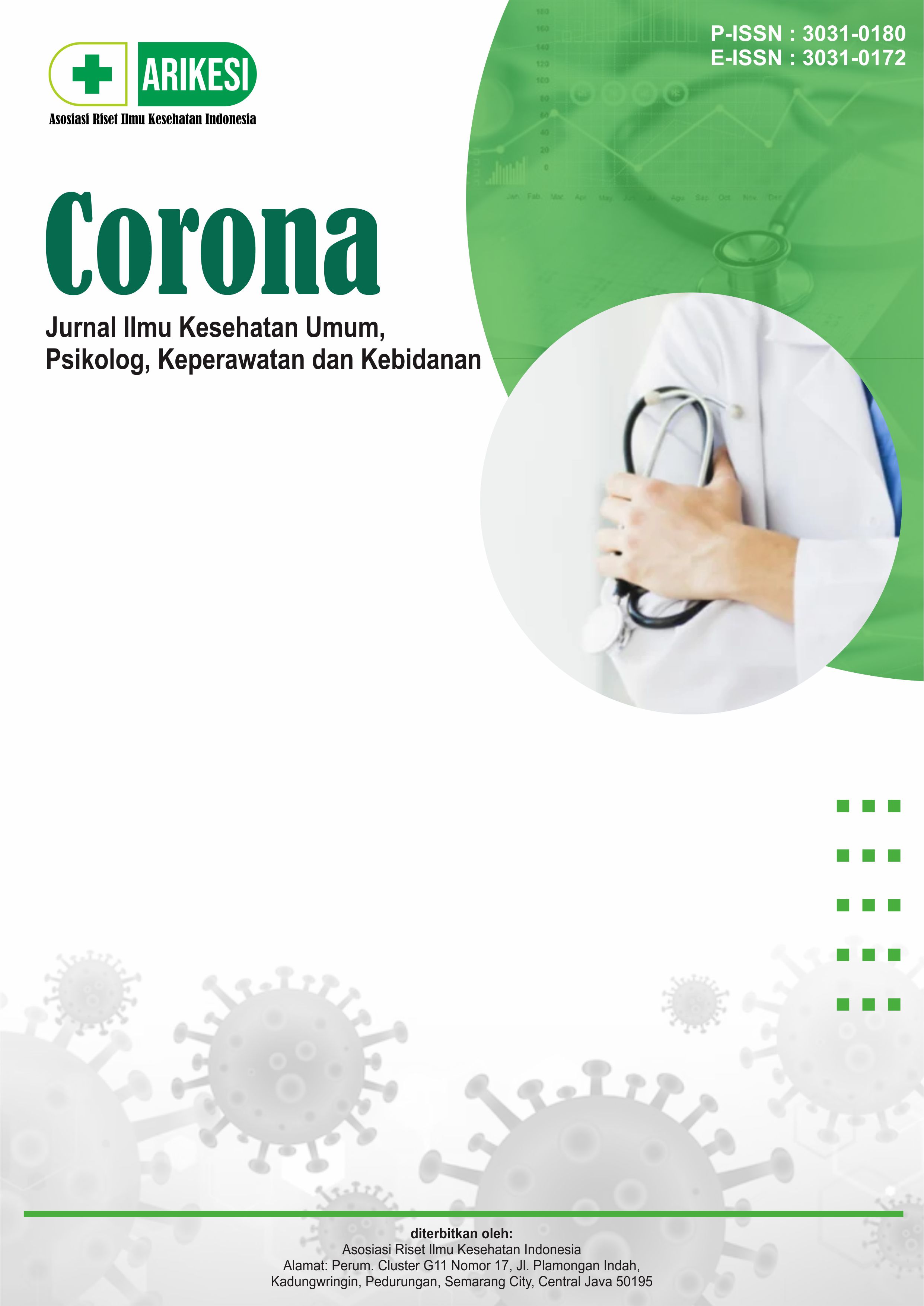Efektivitas Model Peer Education terhadap Tingkat Pengetahuan Ibu Bayi Tentang Praktik Female Genital Mutilation di Desa Sei Suka Deras Kecamatn Sei Suka Kabupaten Batubara Tahun 2024
DOI:
https://doi.org/10.61132/corona.v3i1.1103Keywords:
Peer Education Model, Knowledge, Female Genital Mutilation PracticeAbstract
Globally, at least 100 million girls are at risk of female circumcision each year or almost 6,000 children every day. Female circumcision in Indonesia is generally based on traditions or cultures that are passed down from generation to generation. This study aims to determine the effectiveness of the Peer Education Model on the level of knowledge of mothers and babies about the practice of Female Genital Mutilation. The research method is Quasi Experiment with one group pretest and posttest without control design. The sample size is 50 people according to the inclusion criteria. data with the T statistical test (paired t test). Research results The level of knowledge of the intervention group before the intervention Most have poor knowledge of 12 respondents (48%) and After the intervention, almost Most have good knowledge of 17 respondents (68%). The level of knowledge of the control group before the intervention Most have poor knowledge of 14 respondents (56%) and after the intervention Most have poor knowledge of 14 respondents (56%). It is expected that health workers provide health education and always carry out monitoring and evaluation at the Health Center or other health service centers to conduct continuous home visits.
Downloads
References
Alhassan, A., Ziblim, A. R., & Muntaka, S. (2014). A survey on depression among infertile women in Ghana. BMC Women’s Health, 14(1), 42. https://doi.org/10.1186/1472-6874-14-42
Ali, S., Sophie, R., Imam, A. M., Khan, F. I., Ali, S. F., Shaikh, A., & Farid-Ul Hasnain, S. (2011). Knowledge, perceptions and myths regarding infertility among selected adult population in Pakistan: A cross-sectional study. BMC Public Health, 11, 760. https://doi.org/10.1186/1471-2458-11-760
Coddington, C., & D, M. (2011). Comparison of multiple psychological distress measures between men and women preparing for in vitro fertilization. Fertility and Sterility, 95(2), 717–721. https://doi.org/10.1016/j.fertnstert.201
Copel, L. C. (2007). Kesehatan jiwa dan psikiatri: Pedoman klinis perawat (2nd ed.). Jakarta: EGC.
Faramarzi, M., Pasha, H., & Esmaelzadeh, S. (2013). Is coping strategies predictor of anxiety and depression in infertile couples? International Journal of Fertility and Sterility, 5(3), 643–649.
Hashemieh, C., Samani, L. N., & Taghinejad, H. (2013). Assessment of anxiety in pregnancy following assisted reproductive technology (ART) and associated infertility factors in women commencing treatment. Iranian Red Crescent Medical Journal, 15(12). https://doi.org/10.5812/ircmj.14465
Himpunan Reproduksi dan Fertilitas Indonesia & Perhimpunan Fertilitas In Vitro Indonesia. (2013). Infertilitas.
Kendall, P. C. (2012). Child and adolescent therapy: Cognitive behavior procedures (4th ed.). New York: The Guilford Press.
Manuaba, I. B. G. (2010). Memahami kesehatan reproduksi wanita (2nd ed.). Jakarta: EGC.
Masoumi, S. Z., Poorolajal, J., & Keramat, A. (2013). Prevalence of depression among infertile couples in Iran: A meta-analysis study. Journal of Reproductive and Infertility, 42(5), 458–466.
Musa, R., Ramli, R., Yazmie, A. W. A., Khadijah, M. B. S., Hayati, M. Y., Midin, M., … Ravindran, A. (2014). A preliminary study of the psychological differences in infertile couples and their relation to the coping styles. Comprehensive Psychiatry, 55(SUPPL. 1), S65–S69. https://doi.org/10.1016/j.comppsych.2013.01.001
Ogawa, M., Takamatsu, K., & Horiguchi, F. (2011). Evaluation of factors associated with the anxiety and depression of female infertility patients. Journal of Reproductive Medicine, 56(1), 1–5.
Omu, F. E., & Omu, A. E. (2010). Emotional reaction to diagnosis of infertility in Kuwait and successful clients’ perception of nurses’ role during treatment. Psychiatry, 55(SUPPL. 1), S65–S69. https://doi.org/10.1016/j.comppsych.2013.01.001
Ramezanzadeh, F., Aghssa, M. M., Abedinia, N., Zayeri, F., Khanafshar, N., Shariat, M., & Jafarabadi, M. (2004). A survey of relationship between anxiety, depression, and duration of infertility. BMC Women’s Health, 4(1), 1–9. https://doi.org/10.1186/1472-6874-4-9
Stuart, G. W. (2016). Prinsip dan praktik keperawatan kesehatan jiwa (B. A. Keliat, Ed.). Singapore: Elsevier.
Sultan, S., & Tahir, A. (2011). Psychological consequences of infertility. Hellenic Journal of Psychology, 8(2), 229–247. https://doi.org/10.1007/978-1-4684-5362-1_18
Tabong, P. T. N., & Adongo, P. B. (2013). Infertility and childlessness: A qualitative study of the experiences of infertile couples in Northern Ghana. BMC Pregnancy and Childbirth, 13, 81. https://doi.org/10.1186/1471-2393-13-81
Videbeck, S. L. (2010). Buku ajar keperawatan jiwa (Psychiatric mental health nursing). Jakarta: EGC.
Downloads
Published
How to Cite
Issue
Section
License
Copyright (c) 2025 Corona: Jurnal Ilmu Kesehatan Umum, Psikolog, Keperawatan dan Kebidanan

This work is licensed under a Creative Commons Attribution-ShareAlike 4.0 International License.





